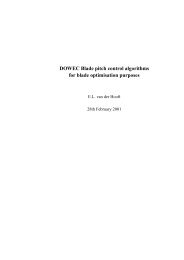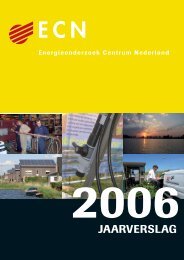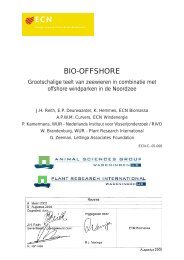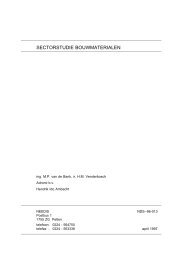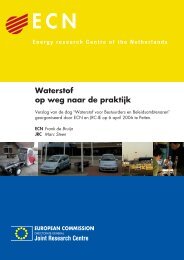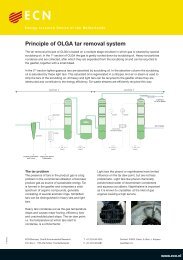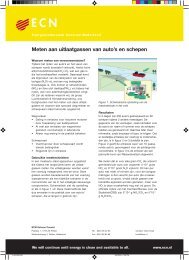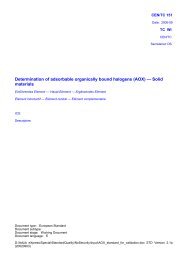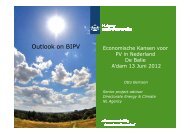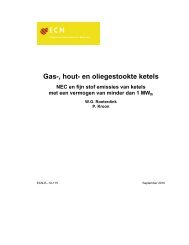PDF format (503 kB) - ECN
PDF format (503 kB) - ECN
PDF format (503 kB) - ECN
You also want an ePaper? Increase the reach of your titles
YUMPU automatically turns print PDFs into web optimized ePapers that Google loves.
Fuel cell passenger car with MF, ITA, RB Not yet available 54 %<br />
Hybrid passenger car with MF, ITA, RB (high ERE value) 31 % 32 %<br />
Hybrid passenger car with MF, ITA, RB (low ERE value) 36 % 37 %<br />
Electric vehicle with MF, ITA, RB (high ERE value) 35 % 44 %<br />
Electric vehicle with MF, ITA, RB (low ERE value) 54 % 59 %<br />
With the new passenger cars, new possibilities to reduce the energy consumption are introduced. The ERE<br />
value for electricity dominates the outcome of the calculation. In a situation with a low ERE value (1.2 MJ/MJ),<br />
the electric vehicle is the most promising option. A reduction of 54% can be achieved with this vehicle by 2020.<br />
With a high ERE value, the fuel cell passenger car is the most promising option by 2050. By 2020, when this<br />
technology is not yet available, the electric vehicle performs slightly better than the hybrid and diesel passenger<br />
car. Considering both cases, about 55 % energy reduction is possible by 2050 (the electric vehicle having a<br />
maximum share of 70 %).<br />
Implementing category 3 improvement options<br />
The preceding two subsections showed that with only technological options, halving the energy use is possible<br />
in 2050. This is still far away from the goal of 90% reduction in this year. To achieve such an energy reduction,<br />
more stringent options should be included.<br />
Next to the options in category 1 and 2, there are category 3 improvement options. Implementing these options<br />
not only decreases the energy use, but in most cases also diminishes the costs associated with transport. Table 4<br />
lists the results of the implementation of the non technological improvement options.<br />
Table 4. Effect of non technological improvement options<br />
Set of options 2020 2050<br />
Without non-technological options 37 % 54 %<br />
With increased vehicle life (+ 2.5 year) 39 % 56 %<br />
With 850 kg passenger car 46 % 60 %<br />
With average occupancy of 3 passengers 68 % 77 %<br />
Doubled public transport share 40 % 57 %<br />
With all non-technological options combined 72 % 80 %<br />
With all non-technological options except doubled public transport share 74 % 81 %<br />
Table 4 shows that especially the doubling of the average occupancy rate in passenger cars substantially influences<br />
the average energy demand. When this high average occupancy rate is combined with small vehicles and<br />
an increased vehicle life, the energy use per passenger kilometre in a passenger car is even lower than in public<br />
transport. Therefore, adding a doubled share for public transport results in a lower reduction. However, such a<br />
high occupancy rate may be very hard to realise when not all single persons trips are made by public transport.<br />
Adding the non technological options results in an 80% energy reduction in 2050.<br />
Implementing category 4 improvement options<br />
With all possible options to reduce the energy consumption of a given mobility demand implemented, a reduction<br />
of about 70 % in 2020 and 80 % in 2050 can be achieved. This means that halving the energy use in 2020<br />
seems possible, but reducing the energy in 2050 with 90% cannot be achieved with the options presented. To<br />
achieve a 90% energy reduction of passenger transport, mobility demand per person should be halved. Several<br />
options can contribute to such a decrease, for example by changing spatial settings, reducing commuter travel<br />
or introducing telecommuting at home. Changes in activity patterns may also contribute to a reduction of the<br />
individual mobility demand. Next to that, a shift to an increased use of soft modes is a possibility to reduce the<br />
energy consumption of transport.



